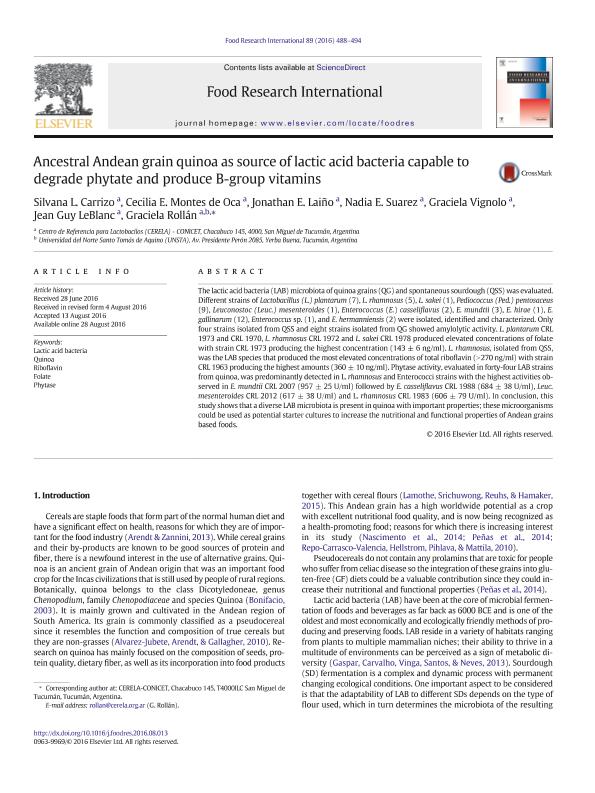Artículo
Ancestral Andean grain quinoa as source of lactic acid bacteria capable to degrade phytate and produce B-group vitamins
Carrizo, Silvana Lorena ; Montes de Oca, Cecilia Estefania
; Montes de Oca, Cecilia Estefania ; Laiño, Jonathan Emiliano
; Laiño, Jonathan Emiliano ; Suárez, Nadia Elina
; Suárez, Nadia Elina ; Vignolo, Graciela Margarita
; Vignolo, Graciela Margarita ; Leblanc, Jean Guy Joseph
; Leblanc, Jean Guy Joseph ; Rollan, Graciela Celestina
; Rollan, Graciela Celestina
 ; Montes de Oca, Cecilia Estefania
; Montes de Oca, Cecilia Estefania ; Laiño, Jonathan Emiliano
; Laiño, Jonathan Emiliano ; Suárez, Nadia Elina
; Suárez, Nadia Elina ; Vignolo, Graciela Margarita
; Vignolo, Graciela Margarita ; Leblanc, Jean Guy Joseph
; Leblanc, Jean Guy Joseph ; Rollan, Graciela Celestina
; Rollan, Graciela Celestina
Fecha de publicación:
28/11/2016
Editorial:
Elsevier Science
Revista:
Food Research International
ISSN:
0963-9969
Idioma:
Inglés
Tipo de recurso:
Artículo publicado
Clasificación temática:
Resumen
The lactic acid bacteria (LAB) microbiota of quinoa grains (QG) and spontaneous sourdough (QSS) was evaluated. Different strains of Lactobacillus (L.) plantarum (7), L. rhamnosus (5), L. sakei (1), Pediococcus (Ped.) pentosaceus (9), Leuconostoc (Leuc.) mesenteroides (1), Enterococcus (E.) casseliflavus (2), E. mundtii (3), E. hirae (1), E. gallinarum (12), Enterococcus sp. (1), and E. hermanniensis (2) were isolated, identified and characterized. Only four strains isolated from QSS and eight strains isolated from QG showed amylolytic activity. L. plantarum CRL 1973 and CRL 1970, L. rhamnosus CRL 1972 and L. sakei CRL 1978 produced elevated concentrations of folate with strain CRL 1973 producing the highest concentration (143 ± 6 ng/ml). L. rhamnosus, isolated from QSS, was the LAB species that produced the most elevated concentrations of total riboflavin (> 270 ng/ml) with strain CRL 1963 producing the highest amounts (360 ± 10 ng/ml). Phytase activity, evaluated in forty-four LAB strains from quinoa, was predominantly detected in L. rhamnosus and Enterococci strains with the highest activities observed in E. mundtii CRL 2007 (957 ± 25 U/ml) followed by E. casseliflavus CRL 1988 (684 ± 38 U/ml), Leuc. mesenteroides CRL 2012 (617 ± 38 U/ml) and L. rhamnosus CRL 1983 (606 ± 79 U/ml). In conclusion, this study shows that a diverse LAB microbiota is present in quinoa with important properties; these microorganisms could be used as potential starter cultures to increase the nutritional and functional properties of Andean grains based foods.
Palabras clave:
Folate
,
Lactic Acid Bacteria
,
Phytase
,
Quinoa
,
Riboflavin
Archivos asociados
Licencia
Identificadores
Colecciones
Articulos(CCT - NOA SUR)
Articulos de CTRO.CIENTIFICO TECNOL.CONICET - NOA SUR
Articulos de CTRO.CIENTIFICO TECNOL.CONICET - NOA SUR
Articulos(CERELA)
Articulos de CENTRO DE REFERENCIA PARA LACTOBACILOS (I)
Articulos de CENTRO DE REFERENCIA PARA LACTOBACILOS (I)
Citación
Carrizo, Silvana Lorena; Montes de Oca, Cecilia Estefania; Laiño, Jonathan Emiliano; Suárez, Nadia Elina; Vignolo, Graciela Margarita; et al.; Ancestral Andean grain quinoa as source of lactic acid bacteria capable to degrade phytate and produce B-group vitamins; Elsevier Science; Food Research International; 89; 28-11-2016; 488-494
Compartir
Altmétricas



